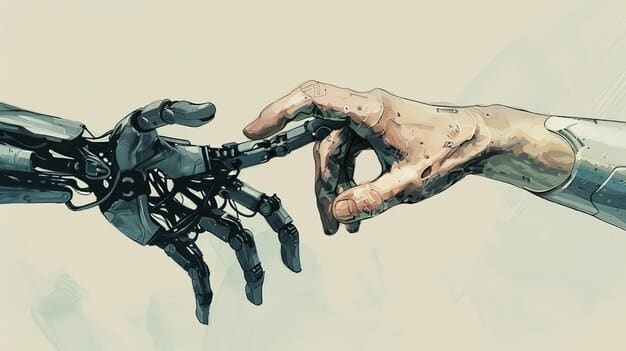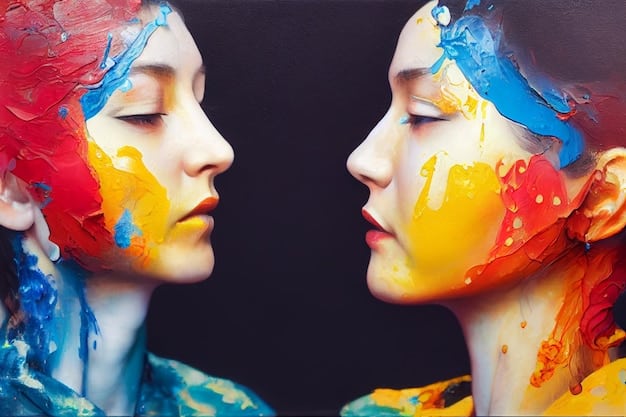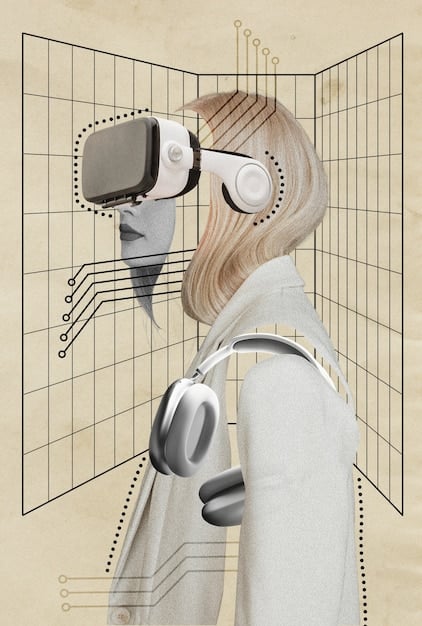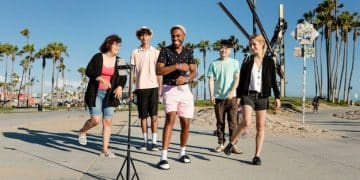The Ethics of AI-Generated Content: Copyright & Creativity in the US

The ethics of AI-generated content in the US encompass navigating complex copyright laws, fostering human creativity alongside AI capabilities, and addressing potential job displacement.
The rapid advancement of artificial intelligence has ushered in a new era of content creation, sparking crucial ethical debates, particularly concerning the ethics of AI-generated content: navigating copyright and creativity in the US.
Understanding AI-Generated Content
Artificial intelligence is no longer confined to the realms of science fiction. It’s actively shaping the creative landscape, producing text, images, music, and more. Understanding the scope of AI-generated content is crucial for grasping the ethical challenges it presents.
Defining AI-Generated Content
AI-generated content refers to any form of media created, at least in part, by artificial intelligence algorithms. This can include:
- Text: Articles, blog posts, scripts, poems, and even code.
- Images: Digital artwork, illustrations, and photorealistic images.
- Music: Compositions, soundtracks, and even the creation of entire musical genres.
- Video: Short films, animations, and deepfakes.
The Rise of AI in Content Creation
The increased accessibility and sophistication of AI tools have made it possible for individuals and businesses to generate content with unprecedented speed and efficiency. This has led to a surge in AI-generated content across various industries, from marketing to entertainment.

AI’s capabilities in content creation continue to evolve, blurring the lines between human and machine creativity, and creating a necessity to understand the ethical implications of this evolution.
Copyright Law and AI-Generated Works
One of the biggest ethical challenges surrounding AI-generated content is the question of copyright. Existing copyright laws, designed for human creators, struggle to accommodate the complexities of AI authorship.
The Current Legal Framework in the US
In the United States, copyright law generally protects “original works of authorship” fixed in a tangible medium. The key question is, who is the “author” when AI is involved?
The US Copyright Office has taken the stance that only works created by human beings can be copyrighted. This raises important questions about the copyrightability of AI-generated works where there is minimal human input.
Challenges to Traditional Copyright
AI models are trained on vast datasets of existing copyrighted material. This raises a number of concerns:
- Infringement: Does the AI-generated content infringe on the copyright of the original works used for training?
- Authorship: If an AI generates a work that is substantially similar to a copyrighted work, who is liable for infringement?
- Ownership: Who owns the copyright to AI-generated content? The AI developer, the user who prompted the AI or is it uncopyrightable?
These challenges require us to re-evaluate traditional copyright laws to address the unique nature of AI-generated content.
Defining Creativity in the Age of AI
Beyond copyright, the role of AI in creativity challenges our understanding of what it means to be creative. Is AI capable of genuine creativity, or is it simply mimicking human expression?
Human Creativity vs. AI Generation
Traditionally, creativity has been viewed as a uniquely human trait, involving originality, emotional depth, and personal expression. AI, on the other hand, operates based on algorithms and data analysis, raising questions about whether it can truly be creative.
The Role of AI as a Creative Tool
Many argue that AI should be viewed as a tool that enhances human creativity, rather than replacing it. In this view, AI can assist artists, writers, and musicians by automating tedious tasks, generating ideas, and providing new avenues for exploration.

Collaborative Creativity: Humans and AI
One promising approach is collaborative creativity, where humans and AI work together to create new and innovative works. This can involve humans providing the initial concept and direction, while AI assists with the execution and refinement of the final product.
This collaboration highlights the potential for AI to augment human capabilities, opening new frontiers of creative expression.
Ethical Concerns Beyond Copyright
While copyright is a central issue, the ethics of AI-generated content extend far beyond legal considerations. There are broader societal and ethical concerns that need to be addressed.
Misinformation and Deepfakes
One of the most pressing concerns is the potential for AI to generate realistic but fake content, known as deepfakes. These can be used to spread misinformation, manipulate public opinion, and damage reputations.
Job Displacement and Economic Impact
The automation of content creation by AI raises concerns about job displacement. As AI becomes more capable of generating high-quality content, it could potentially replace human writers, artists, and musicians, leading to economic hardship for many.
Bias and Representation
AI models are trained on data, and if that data reflects existing biases, the AI-generated content will likely perpetuate those biases. This can lead to unfair or discriminatory outcomes, particularly in areas such as advertising, news, and entertainment.
Addressing these ethical considerations is crucial for ensuring that AI-generated content is used responsibly and ethically.
The Evolving Landscape of AI Ethics
The field of AI ethics is rapidly evolving, with researchers, policymakers, and industry leaders grappling with the challenges posed by AI-generated content. What are the latest developments and what can we expect going forward?
Developing Ethical Guidelines and Standards
Various organizations are working to develop ethical guidelines and standards for AI development and deployment. These guidelines aim to promote fairness, transparency, and accountability in AI systems, including those used for content creation.
The Role of Education and Awareness
Education and awareness are crucial for fostering a responsible approach to AI-generated content. Individuals and organizations need to understand the capabilities and limitations of AI, as well as the ethical implications of its use.
Future Trends and Predictions
Looking ahead, we can expect AI to become even more sophisticated in its ability to generate content. This will likely lead to new legal and ethical challenges, requiring ongoing dialogue and adaptation.
Staying informed about these issues and participating in the conversation is vital for shaping the future of AI-generated content.
Best Practices for Navigating the Ethics of AI Content
As creators, businesses, and consumers, we all have a role to play in navigating the ethical landscape of AI-generated content. Here are some best practices to consider:
Transparency and Disclosure
When using AI-generated content, it’s important to be transparent about its origin. Disclosing that content was generated by AI can help prevent misinformation and ensure that audiences are aware of its potential limitations.
Human Oversight and Review
AI-generated content should always be subject to human oversight and review. This can help identify and correct any errors, biases, or ethical concerns before the content is published or distributed.
Respecting Copyright and Intellectual Property
It’s essential to respect copyright and intellectual property rights when using AI-generated content. Avoid using AI to create content that infringes on existing copyrights, and be mindful of the licensing terms of any AI tools or datasets.
By following these best practices, we can harness the power of AI for content creation while upholding ethical principles and protecting the rights of creators and consumers.
| Key Aspect | Brief Description |
|---|---|
| 🤖 AI Content Definition | Content generated by AI algorithms, like text, images, music, and video. |
| ©️ Copyright Challenges | Determining authorship and ownership of AI-generated works under current US copyright law. |
| 🎨 AI & Creativity | Exploring if AI can be truly creative or is merely replicating human expression. |
| 📢 Best Practices | Being transparent about AI use, ensuring human oversight, and respecting copyright. |
Frequently Asked Questions
▼
Currently, the US Copyright Office maintains that only works created by human beings are eligible for copyright protection. Works solely generated by AI are not copyrightable.
▼
Liability is complex. It could potentially fall on the user prompting the AI, the AI developer, or it may depend on the specific circumstances and the extent of human involvement.
▼
Be transparent about using AI, provide human oversight, respect copyright laws, and consider the potential biases in AI outputs to ensure fair and responsible usage.
▼
Deepfakes are realistic, AI-generated fake content. They are an ethical concern because they can spread misinformation, manipulate public opinion, and damage reputations, undermining trust.
▼
It’s unlikely AI will completely replace human creatives. Instead, it’s more likely AI will augment human capabilities, helping enhance creative processes and opening new avenues for expression.
Conclusion
Navigating the ethics of AI-generated content in the US requires a multi-faceted approach that considers copyright law, the nature of creativity, and broader societal implications. By promoting transparency, fostering human oversight, and engaging in ongoing dialogue, we can harness the power of AI for content creation while upholding ethical principles and respecting the rights of creators and consumers.





